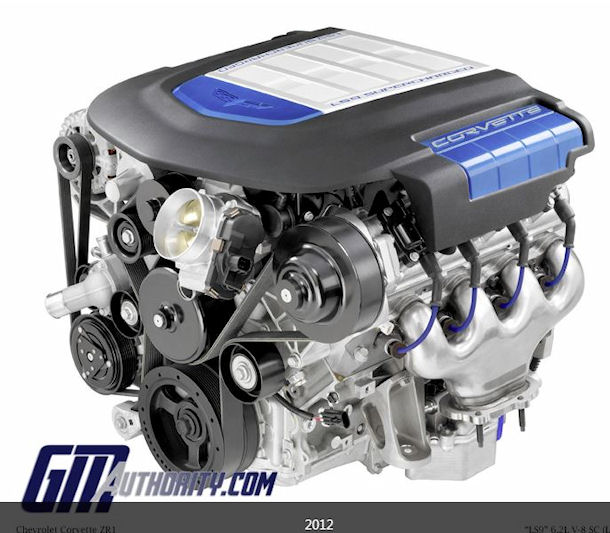- "LS"and "LT" based Crate Engines -
LS-3, LS-7, LS-9, LT-4, LT-5
NOTE: All our Products, Designs and Services are SUSTAINABLE, ORGANIC, GLUTEN-FREE, CONTAIN NO GMO's, and will not upset anyone's precious FEELINGS or delicate SENSIBILITIES.
LS and LT Crate Engine Introduction
The GM LS engines discussed here (LS-3, LS-7, LS-9) are the later "Gen-4" engine versions of the LS series. The LS-7 and LS-9 engines were discontinued in 2017. The information remains here for general interest purposes.
The LT series of engines (LT-1, LT-4, LT-5) are referred to as "Gen-5" engines, which differ in substantial ways from the Gen-4 engines, including the use of direct fuel injection (as opposed to port injection on the Gen-3 and Gen-4 engines), variable valve timing, cylinder deactivation, improved block structure, improved main bearing caps, improved oil system, and a host of other revisions / improvements.
The LS and LT crate engines frequently come up for discussion as potential candidates for the basis of a lightweight liquid-cooled aircraft powerplant. The base LS engine weighs less than 390 pounds (less flywheel, alternator, exhaust manifolds, and accessory drives). Those interested in such a project believe these engines might provide reasonable reliability and power in the factory configuration.
On the subject of reliability, it is worthy of note that in the GM Performance Parts Book, ALL of the LS and LT crate engines have the statement: "NOT INTENDED FOR MARINE USE". And "marine use" can certainly be considered similar to aircraft use, by virtue of long periods of operation at high or maximum power settings.
CRANKSHAFTS
The LS-7, LS-9, LSA, LSX-454, LT-1, LT-4, LT-5, and LT-376 engines use forged steel crankshafts.
ALL other LS engines use CAST IRON crankshafts.
On the subject of forged steel production crankshafts, it is worthy of note that the material used in ALL EXCEPT THREE of the engines with forged cranks is an inexpensive low-alloy AISI-1053 "carbon" steel. The ONLY alloying elements it contains are carbon (0.48-0.55%) and manganese (0.70 - 1.00%), with low allowable amounts of contaminants like phosphorous and sulfur. It has low hardenability and a relatively low endurance limit, but it IS inexpensive.
The three (known) exceptions to those lower-grade 1053 forged crankshafts are: (a) the 3.622" stroke LS-9 crankshaft, (b) the 4.000" stroke LS-7 (that initially was AISI-4140, a decent manganese-chrome-moly-silicon alloy, then was switched to the micro-alloyed compound 44MnSiVS) and (c) the 4.125" stroke LSX-454 crankshaft (P/N 19244018) that is advertised as "premium 4340" forged steel.
For premium crankshafts, AISI-4340 nickel-chrome-moly steel has been used for decades (and still is). Although the LSX-454 is an iron-block engine, therefore suitable (weight-wise) only for some very special case applications such as the Stewart-S-51 (and similar) which NEED a heavy engine to properly locate the aircraft empty-CG, it is noteworthy that the 4.125 inch stroke LSX crankshaft is somewhat alarming with regard to anything except occasional use.
With its 4.125" stroke, 2.100" rod journals and 2.560" main journals, this crank has a crankpin overlap of only 0.268 inches and a CPO cross-sectional area of only 0.195 square inches, compared to 0.519 inches CPO and 0.519 square inches CSA respectively for the LS-9 crank. It is also noteworthy that this long-stroke, small journal crankshaft has no center counterweights.
The LS-7 alloy 44MnSiVS is a precipitation-hardening steel 0.42-0.47% Carbon, 1.3-1.6% Manganese, 0.5-0.8% Silicon and 0.1-0.15% Vanadium) with good tensile and yield properties (159 / 87 ksi) and has the advantage of lower production costs because of precipitation-hardening instead of traditional quench-and-temper.
I have not been able to specifically determine the material used in the LS-9 forged steel crankshaft. However, based on (a) a GM publication describing the engine and (b) on the huge power and torque that engine produces, I would GUESS that the material is the micro-alloyed precipitation-hardening steel used in the LS-7 (discussed above) or a better one.
The GM specification document specifically mentions a "micro-alloyed drop-forged crankshaft". The "micro-alloyed" steels are precipitation-hardening products that were developed to provide a high-strength alternative to conventional quenched-and-tempered crankshaft alloys. One fatigue test I reviewed shows the "T4" micro-alloy having a 10^7 life at 66 ksi in a rotating beam test (fully-reversing stress cycles). Eliminating the Q&T and subsequent straightening processes, while at the same time achieving excellent material strength and fatigue life, could be a significant production cost saving.
The flywheel bolt pattern on the LS-9 engine has 9 bolts to deal with the massive torque that engine produces; the LSA, LSX-454, LT1, LT4, LT-5, and LT-376 have 8 bolts; ALL others have a 6-bolt pattern.
A more detailed discussion of crankshaft engineering and production can be found HERE.
CONNECTING RODS
The LS-7 and LS-9 engines use forged straight I-beam titanium conrods that have very modest cross sections. There is a further discussion of these titanium pieces in the LS-7 section below.
All other LS and LT engines use powdered metal straight I-beam conrods that have a fairly small cross-sectional area and polar moment of inertia (resistance to bending deflection).
PISTONS
The LS-9, LSX-376, LSX-454, LT-4, and LT-5 engines use forged aluminum pistons; ALL other LS / LT engines (as far as I can determine) use cast hypereutectic aluminum pistons.
The forged pistons used in those listed engines are forged 4032 aluminum alloy. Certainly these forged productions are superior to the castings used in the other LS engines. However, the premium piston alloy 2618, developed for aircraft engines by Rolls-Royce during WW-2, is a far stronger and more ductile alloy, and is the one I use in my designs.
The one drawback to 2618 is the fact that it has a substantially greater coefficient of expansion than does 4032, so it requires greater piston-to-wall assembly clearances. Because 4032 does not expand as much as 2618 during the rise to engine operating temperature, an engine using 4032 pistons can be built with much lower piston-to-wall clearances, thereby eliminating the (slightly) annoying piston slap noise during warmup. In an aircraft application, I think the substantially greater strength and ductility of 2618 far outweighs a little noise during warmup.
FURTHER OBSERVATIONS
Based on considerable experience in engine design, component analysis, engine building and engine testing, it is my considered opinion that cast crankshafts, forged crankshafts made from inferior material, and cast pistons DO NOT BELONG in an aircraft engine. That being said, a LIMITED case MIGHT be made for the LS-3, discussed below.
FWIW, I have never built a V8 or V12 aircraft engine that did not have:
- A crankshaft made from either 4330-M (manganese-silicon-chrome-nickel-moly-vanadium) or from 4340 (manganese-chrome-nickel-moly) premium, VAR steels. (The chemistry of those premium steels, and other crankshaft materials, can be seen HERE.)
- Premium 4340 steel H-beam or I-beam connecting rods, and
- forged or billet 2018 alloy ("rolls-royce aluminum") pistons.
In fact, my new 125-HP O-200 Replacement uses those same premium materials.
On the subject of engine power, look carefully at the factory dyno curves (reproduced below) and keep in mind that a reasonable MAXIMUM takeoff engine RPM for a 3.622" stroke engine is around 4900 (for for 2960 Ft/Min mean piston speed). If the stroke is 4.000", (LS-7) then the MAX takeoff RPM will be 4500 (3000 ft/min).
Therefore, that "430 HP" LS-3 or that "505 HP" LS-7 engine that you are drooling over will, in reasonably-configured aircraft service, be limited to 390 / 400 takeoff HP respectively and 300 / 340 cruise HP (sea level standard values).
Also keep in mind that at 10,000 ft MSL, the sea-level-standard power figures will drop to about 74% of their stated sea-level / standard values.
CURRENTLY AVAILABLE ENGINES of POTENTIAL INTEREST
LS-3
The GM LS-3 crate engine (GM Part Number 19301326) frequently comes up for discussion as a candidate for a lightweight liquid-cooled aircraft powerplant. The LS-3 weighs less than 390 pounds complete (less flywheel, alternator, and accessory drives). Those in favor of its use believe it might provide reasonable reliability and power in the factory configuration.
The graph below shows the power and torque curves for the stock LS-3, 6.2 L (376-CI) engine.
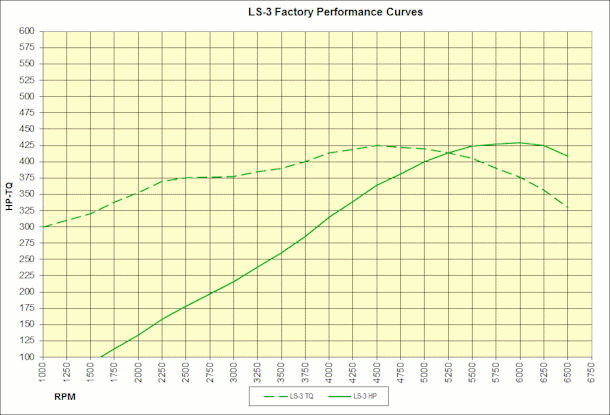
Note that the power peak for the LS-3 is 430 HP, but that power level; occurs at 5900 RPM. Keep in mind that the engine is tailored for high-performance street vehicles (and for the ability to advertise 430 HP).
At 5900 RPM (power peak), the mean piston speed (MPS) is 3561 fpm. It is interesting to note that every aircraft piston engine designed to operate at sustained mean piston speeds over about 3000 fpm have been short-lived. We have demonstrated with previous engines that mean piston speeds (MPS) of 2900 and 2600 FT/MIN for takeoff and cruise respectively are reasonable for extended life, all other things being correct.
Because of the relatively flat torque curve (shown above), a stock LS-3 MIGHT make a reasonable aircraft powerplant IF IT IS LIMITED to operation at substantially below peak available power. I say that because, despite the automotive load model components in this engine, there are RUMORS that GM randomly pulls samples of these engines from the production line and runs endurance tests on them, subjecting them to 100 hours on a dyno at wide open throttle (WOT), cycling between max power and max torque. IF that is the case, then this engine MIGHT work if the suggested limitations are imposed on its operation. NOTE: that statement is pure speculation on my part --- I have NO DATA whatsoever to support it.
And, keep in mind, the engine uses a cast iron crankshaft (instead of the high-grade Nickel-Chrome-Moly steel used in certified and high-performance engines), powdered-metal, straight, thin I-beam connecting rods (no comment necessary), cast aluminum pistons, and a plethora of other components designed for the automotive engine load scenario.
If the takeoff and cruise RPM are constrained to 4900 and 3900 respectively, the engine provides a respectable takeoff power of about 390 sea-level, standard HP (4900 RPM = 2958 FT/MIN mean piston speed) and about 310 sea level, standard HP for max cruise (3900 RPM = 2354 Ft/Min MPS).
However, it is important to match the maximum propeller speed and power absorption capacity to a takeoff engine RPM of 4900. For the 390 HP range, a propeller which can turn in the vicinity of 2600-2700 RPM MIGHT be suitable (see Selecting the Right Propeller).
The ratio required for 4900 / 2700 is about 1.814. With that ratio, at 3900 engine RPM, the propeller would be at 2150 RPM. Using the selected ratio, examine your propeller performance curve to see how well it will operate with the available power at the propeller RPM provided by the selected cruise RPM and reduction ratio.
And don't forget the effectiveness of the propeller governor at cruise RPM. Hydraulic prop governors have a LIMITED range of effective speeds.
HOWEVER, before running off to buy an LS-3, take a close look at the Engine Conversions section of this site, especially the page titled Evaluating a Conversion.
Bottom line: does 390 HP justify a powerplant package in excess of 900 pounds?
LT-5 Engine
The LT-5 is listed in GM literature as: "OUR FASTEST CRATE ENGINE EVER", and "...THE MOST POWERFUL ENGINE EVER OFFERED IN A CHEVY PRODUCTION VEHICLE". And the baseline power ouput of 755 HP (at 6400 rpm) would seem to support those claims. The curve below shows the (impressive) power and torque curves for a box-stock LT-5.
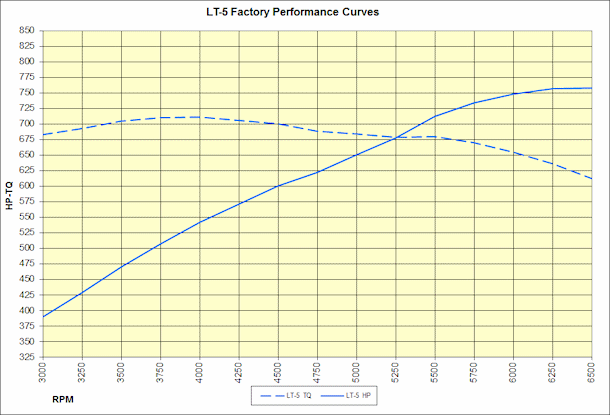
Examining the (reproduced) factory dyno curve above, it is noteworthy that the torque curve for this engine exceeds 650 LB-FT from 3000 RPM to 6000 RPM, and the peak power is 755 HP at 6500 RPM.
This engine is an evolution from the LS-9 and LT-4 supercharged engines, with more evolutionary improvements. It retains the well-proven 4.060 bore and 3.622 stroke engine dimensions, for 376 cubic inched (6.2 liters).
This engine uses a drop-forged crankshaft made from premium micro-alloyed steel, that incorporates the 8-bolt flywheel attachment flange. The pistons are forged 4032 aluminum (discussed above), but the conrods are an improved powder-metallurgy product (more on that later).
The lubrication system is dry-sump, and requires the addition of a suitable oil tank and oil system plumbing (which must be added to the installed weight calculation for the powerplant). The lubrication system includes oil jets that spray cooling oil onto the bottom of the pistons.
This engine uses an improved, higher adiabatic efficiency Eaton 4-lobe helical supercharger that displaces 2.65 liters per revolution. The supercharger also has improved bypass valve technology and a 95mm throttle body for less restriction in the inlet side of the supercharger. The charge cooling system has enlarged heat exchangers with almost twice the capacity of that on the LT-4, in order to sustain a well-cooled intake charge at continuous high boost operation. Of course, suitable charge coolant pumps and air-to-coolant heat exchangers will be required on the vehicle to produce that desired effect.
As part of the Gen-5 family, it uses direct fuel injection fed by a sophisticated 3-lobe pump run off the camshaft, with eight supplmemtary fuel injection nozzles in the intake ports to support the fuel flow required for the very high output, while at the same time keeping the main (direct) injectors sized so as to provide good low-flow response and accuracy. It also incorporates the well-proven variable valve timing and selective cylinder deactivation features (although I do not see much usefulness for cylinder deactivation in an aircraft application).
The following picture shows a view of the LT-5, copied from one of the GM web pages.
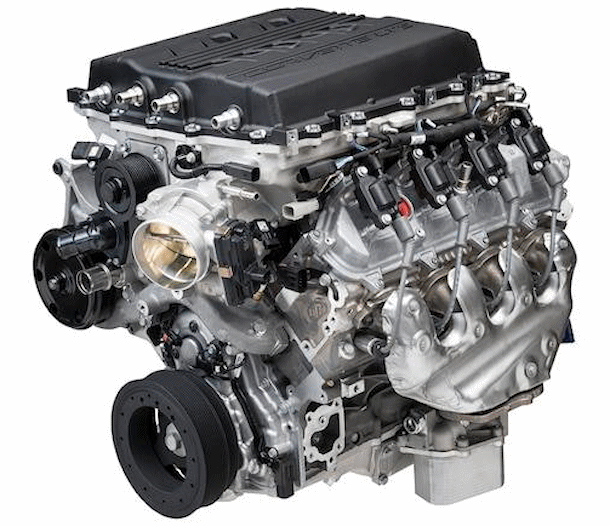
LT-5 Complete Engine
In a sensible aircraft application, the LT-5 MIGHT be successful with the imposition of a takeoff limit of 4500 RPM, which provides 600 HP. Using a cruise RPM of 3600 produces 500 HP (sea-level, standard conditions, at WOT). Those are very impressive numbers, and are well below the max power the engine is ADVERTISED for.
Katech Engineering is a major development company that does a significant amount of high performance work for GM. In 2019, they did a torture test of the LT-5 to examine (a) how much power it could relianbly produce, and (b) when it broke, what would give up first. That video can be seen HERE.
The important takeaway is that, using the stock OEM bottom end components, they managed an amazing 1486 HP from the engine without breaking it. BUT, when they tore the engine down after that series of tests, they discovered it was just about to grenade, and the parts that were giving up were - - - the powdered-metal conrods.
But that really says a lot for the OEM engine. It had well over 100 dyno pulls at 1200 HP and above. Again, dyno pulls are NOT THE SAME as extended operation at full throttle at one RPM. AND just to put that in perspective, a controlled dyno pull takes roughly 10 to 15 seconds. So a hundred dyno pulls totals approximately 25 MINUTES.
It is very interesting that, after making some baseline dyno test runs (to verify factory numbers), they did some MINOR modifications (replaced the OEM exhaust manifolds with a proper set of tube headers, used 104-octane racing fuel, and re-mapped the spark and fuel curves to take advantage of the better fuel. The impressive results are shown in the following graph, compared to the box-stock engine.
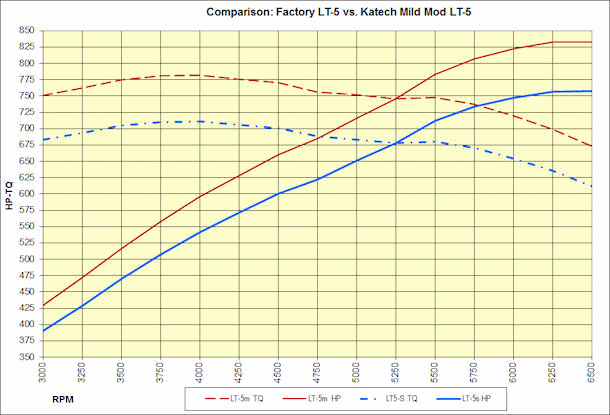
LS-9 Engine (discontinued)
The LS-9, discontinued in 2017, is a remarkable supercharged 6.2 L (376 CI) engine with all manner of special componentry and some very clever engineering. The torque curve exceeds 550 LB-FT from 2700 RPM to 5600 RPM, and the peak power is 638 HP at 6500 RPM, as shown in this plot of factory power and torque figures for the LS-9.
As mentioned above, this engine uses a forged steel crankshaft from a premium micro-alloyed material and forged aluminum pistons. The conrods are titanuim, discussed further in the LS-7 section below.
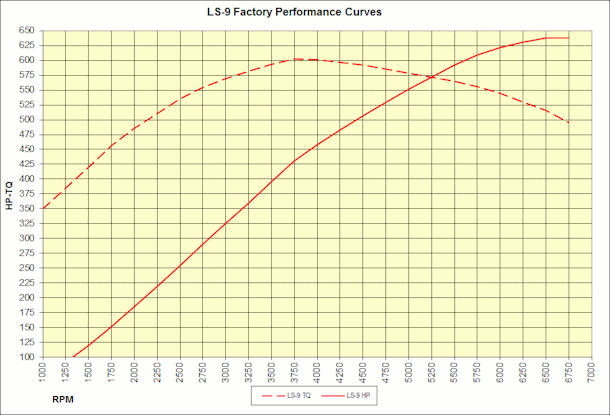
As with previous discussions, aircraft usage of this engine should be limited to about 4750 RPM (takeoff) for 529 HP, and 3750 (cruise) for 425 HP.
GM has provided a fairly-complete summary of the engine features HERE, which also contains the following picture of an older version of this engine.
LS-9 Complete Engine
The following chart shows a comparison between the LS-3, LS-7 and LS-9 power and torque curves.
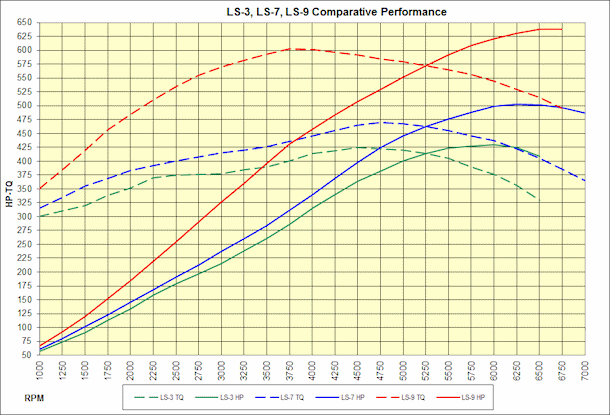
Note that for the high-power supercharged LS-9 engine (and for the current high-power supercharged LT-4 and LT-5 engines), GM abandoned the problematic 4.125" bore of the LS-7 block, opting for a 4.065" bore (stronger, straighter cylinder walls and a thicker cylinder liner).
They also improved the crankshaft (over the LS-7) by using a forged steel 3.622" stroke crankshaft with a CPO of 0.519 inches and an overlap cross sectional area of 0.516 in², and provided a flywheel-attachment flange having nine 11-mm attach bolts in place of the standard six bolts(and 8 on a few).
I have been unable to definitively establish the material used for this crank, but based on the power and torque numbers the engine produces, I am GUESSING it is the same or similar to the LS-7 crankshaft material discussed above under LS CRANKSHAFTS.
As discussed in the introduction, the LS-9 uses forged pistons in 4032 alloy. As detailed above, I much prefer the superior strength and ductility of 2618 alloy forged pistons. Those superior properties far outweigh a little additional piston slap noise during warmup.
The LS-9 also uses forged titanium conrods (discussed below in the LS-7 section), 6-bolt cross-bolted steel main bearing caps (instead of the cast iron in other engines) and a dry sump oiling system with oil squirt jets to cool the pistons. (The dry sump system means that the weight of an oil tank, de-aerator, and appropriate plumbing must be added to the powerplant weight tally.)
The supercharger is an Eaton helical 4-lobe positive displacement unit which moves 2.3 liters of air (STP) per revolution, and can flow as much as 2844 kg/hour at a pressure ratio of 2.38. It provides reasonable compressor efficiency, with the map showing a peak island claiming 72% isentropic efficiency, and a very large island showing 65% or more, but at maximum performance, the efficiencies hover between 55 to 60%.
This line of superchargers incorporates a clever bypass system that eliminates most of the supercharger drive power when boost is not required. At max boost, however, this blower (according to the manufacturer) can consume as much as 107 KW (144 HP).
Keep in mind that the power to drive the blower is IN ADDITION to the power delivered to the flywheel, so that means (a) greater loads on the engine internals, (b) greater heat rejection requirements, and (c) substantially higher fuel specifics (BSFC).
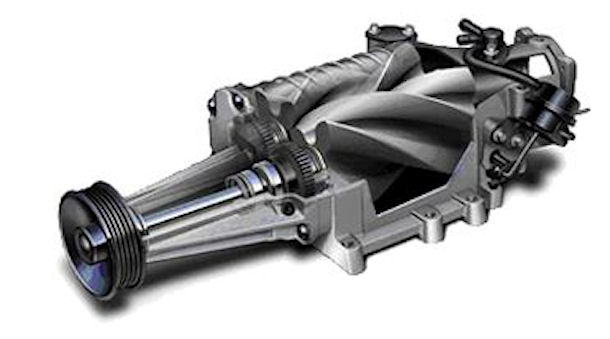
Eaton 2.3 Liter 4-Lobe Helical Supercharger
This supercharger is driven by a micro-V belt from a pulley on the nose of LS-9 crankshaft. The belt is shared with the coolant pump and HX pump, and the pulley centerline is quite far forward on the crankshaft snout, thereby applying a large fully-reversing bending moment to the small snout at high power operation.
That belt drive is perhaps a bit worrisome with respect to long term reliability under high power transmission (aircraft) usage. The upside is that if the belt fails, the engine will still operate naturally-aspirated but at substantially-reduced power. The downside is that the coolant pump will no longer operate, so the engine operation timeline would be VERY limited.
The LS-9 intake system includes a very clever liquid-to-air intercooler that is sandwiched between the blower outlet and the intake manifold inlet. It is very compact, and probably suitable for most automotive applications. In the automotive installations, the vehicle includes a separate nose-mounted air-to-liquid heat exchanger (HX) and a pump that circulates the coolant from the intercooler to the forward HX and back.
That means that, in automotive usage, the entire charge of coolant is just above ambient air temperature most of the time. When a burst of full throttle usage occurs, the intercooler depends on the short-term heat absorption capacity of the coolant because the HX capacity is not capable of sustained removal of the heat of compression transferred by the intercooler. So for a sustained high-power application, the installation would need to provide a larger air-to-liquid HX and MAYBE a larger HX pump to handle the steady-state cooling requirements of the intercooler.
I have not found a definitive weight for the LS-9, but starting with the known LS-7 figure of 390 pounds, then adding in (an estimated) 20 pounds for the alternator and accessory drive components, and (estimated) 80 pounds for the supercharger, intercooler, intercooler coolant pump, intercooler HX, dry sump oil tank and plumbing, the engine weight is nearly 500 pounds BEFORE accounting for the 110 additional pounds for a propeller, a gearbox, and the flywheel portion of the torsional absorber.
So again, you have to ask: Does 525 HP (max) justify a powerplant package in excess of 900 pounds?
LS-7 Crate Engine (discontinued)
The LS-7 engine became available in late 2006, and was discontinued in 2017. When it was introduced, it represented a new era in factory-crate engines. It is based on the GM Gen-4 LS series, with 427 cubic inches of displacement (4.125 x 4.000) and its own special block, crankshaft, rods, cylinder heads and valves.
The block and heads are all-aluminum. The ports and combustion chambers are CNC-machined and provide very high flow numbers. The crankshaft is forged-steel instead of the currently-popular castings. The conrods are titanium (in an unspecified alloy).; The pistons are castings; The 1.8 ratio invertment-cast rocker arms have roller trunnions. The engine has 2.20 inch titanium intake valves, 1.61-inch sodium-filled exhaust valves, and a dry-sump oil system.
Techniques which were previously limited to custom engine shops are used in the production of this engine. For example, the final honing on the (special) block is done with deck plates torqued in place and with the main caps installed and torqued. Each engine is assembled by one technician, who signs the worksheets. Each engine is test-run at the GM engine factory before shipping.
The following graph shows the factory power and torque curves for the LS-7 engine.
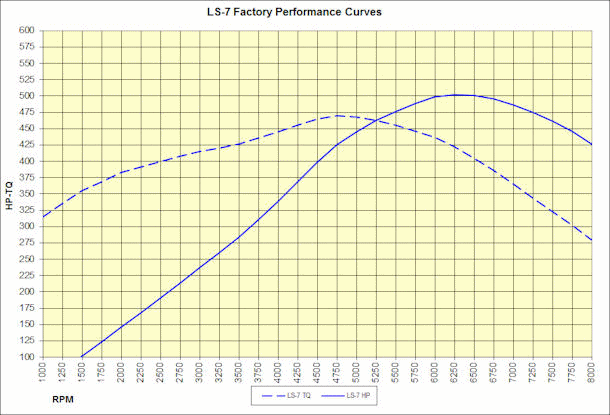
Again, note that the impressive 505 HP occurs at 6300 RPM, and with the 4.000" stroke crankshaft (which has a rather low CPO value), 6300 RPM is a MPS of 4200 FT/MIN.
Applying the sensible (long life) MPS numbers (4500 RPM - 3000 FPM for takeoff - - - 3800 RPM - 2533 FPM for cruise) for this engine (discussed in the introduction), the more realistic sea-level-standard power numbers are 400 / 317 HP for takeoff and cruise respectively.
The blue lines in the graph below shows the stock LS-7 torque and power curves compared to those of the LS-3 (green) discussed above.
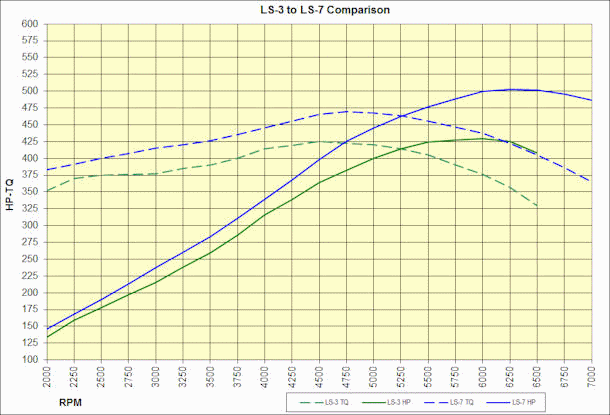
The following details of the LS-7 engine are presented as a matter of general interest.
As pictured below, the engine weighs about 390 pounds, but (as pictured) it has no flywheel, no accessories, and no accessory drive system. Further, this engine has a dry-sump oiling system, which requires the addition of an oil tank and appropriate plumbing, all of which increase the impressive-sounding 390 pounds and must be taken into consideration in the airframe weight analysis. (NOTE the lovely standard, hydroformed, double-wall stainless steel headers).
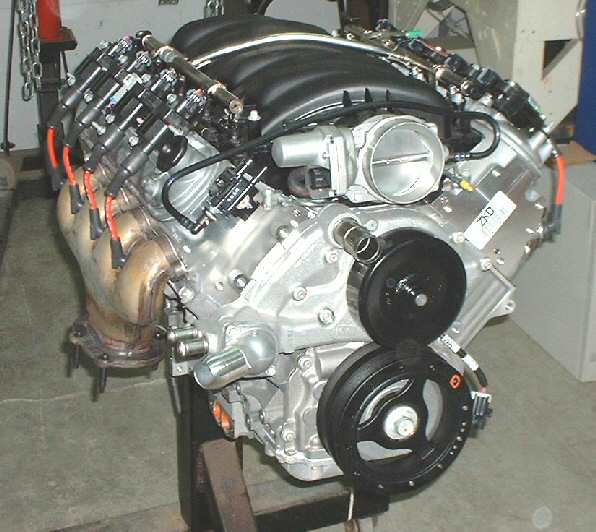
LS-7 Engine (Nearly Complete)
This picture shows the roller rockers and the special intake ports used in the LS-7 head. The LS-7 head design has been rolled over to 12 degrees (LS-2 and 6 are 15°), the intake ports have been raised and reshaped from the familiar "cathedral" shape of the earlier LS family engines. The LS-7 uses special, 1.8 ratio investment-cast roller-trunnion rocker arms. The exhaust rocker is in-line, but the center of the pushrod socket in the intake rockers is offset about 0.300" to the right, which tilts the intake pushrod enough to clear the wider intake port. The new intake ports flow in excess of 340 CFM. (For comparison purposes, the best of the Gen-1 smallblock heads we developed for our 500 HP engine flowed about 320 CFM while maintaining an excellent velocity profile).
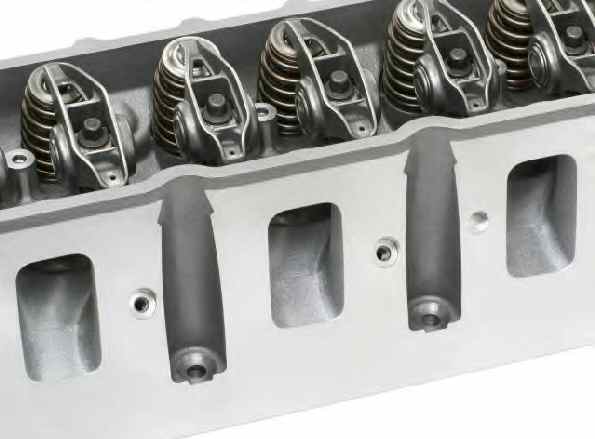
LS-7 Cylinder Head - Intake Side
The heads have 2.20-inch titanium intake valves and 1.61-inch, hollow-stem, sodium-filled exhaust valves (for substantially-reduced valvetrain effective mass), and beehive valve springs which avoid some of the problems associated with focused spring resonant frequencies.
The LS-7 has a forged steel crankshaft. The early versions were AISI-4140, and the later versions are 44MnSiVS, a precipitation-hardening alloy. Note the absence of center counterweights (discussed further in CRANKSHAFT DESIGN).
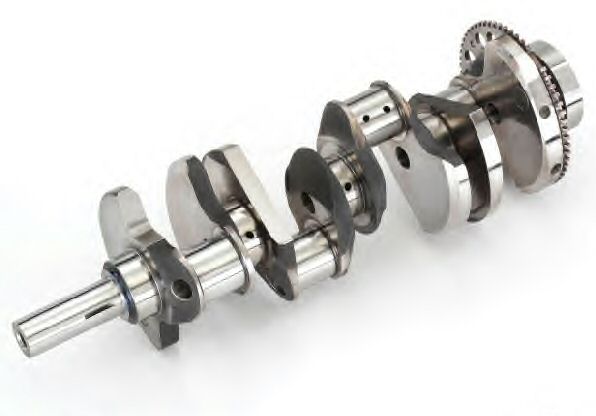
LS-7 Forged Steel Crankshaft
The LS-7 crankshaft design has issues with respect to sustained, High RPM, High-Load usage. First, as the crankshaft picture above shows, the center main bearing has no counterweights on either side. That causes a cyclic bending problem across the center main, since at TDC / BDC on both banks, the center two cylinders are applying loads to the crankshaft in opposite directions, which add together to produce a much larger bending load across that center main bearing.
The problem is made worse by the low crankpin overlap (CPO) provided by a crank with a 4.000 inch stroke and the relatively small main and rod bearing journals (2.560 and 2.100) discussed earlier in this article.
The next picture shows the LS-7 piston and connecting rod. The pistons are aluminum castings (by Mahle) in an allegedly hypereutectic alloy, and provide the engine with a static compression ratio of 11:1. The narrow, straight I-beam connecting rods are made from a titanium forging. I have been unable to determine the titanium alloy used. I asked several highly-placed GM sources, but none would reveal the alloy.
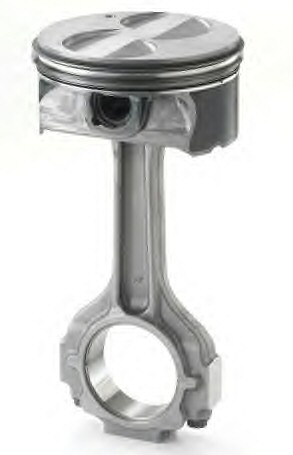
LS-7 Titanium Rod and Cast Aluminum Piston
Regarding these titanium rods, I have the following suspicions:
- Despite their being advertised as a "feature" I think they are required in order to get the engine to balance - - - in addition to lightweight (TI) rods, the production crankshaft needs tungsten slugs in the front and rear counterweights to balance as it is;
- A high quality set of 8 custom titanium 6al-4v conrods costs roughly 1/3 the total cost of the LS-7 engine, so the material used in the production engine is definitely questionable,
- The small I-beam (shown in the picture) is unsuitable for an aircraft application in a quality STEEL alloy (based on a lot of design and FEA work on conrods), so the use of a material in a small-beam conrod having 60% of the Young's Modulus and a much lower tensile and yield strength than quality steel is an eyebrow-raiser.
When I mentioned to one very knowledgeable GM Racing Tech that the reason for my deep interest in the LS-7 was the potential use in an aircraft, he said he would DEFINITELY recommend replacing the OEM TI rods with a stout set of aftermarket steel H-beam rods (although he would not reveal the TI alloy in subsequent pointed questioning).
The LS-7 has a dry-sump oiling system with an internal two-stage oil pump (pressure and scavenge) driven off the nose of the crankshaft (same location as the single-stage LS-1 / 2 / 3 / 6 pump). The scavenge pump has approximately 1.5 times the capacity of the pressure pump. The oiling system also includes eight oil-squirt jets, that spray oil onto the underside of each piston and onto the cylinder walls as well. That carries away a substantial quantity of heat from the pistons under high load.
An additional issue with this engine (in aircraft service) is the fact that with the 4.125 inch bore in an aluminum block with 4.400 inch bore spacing, the minimum spacing between adjacent cylinders is 0.275" (just a bit over 1/4"). That spacing determines the thickness of the two adjacent press-fit cylinder liners AND the available aluminum structure needed to support those liners.
GM discovered early in their production process on this engine that maintaining an acceptable bore straightness and roundness was problematic. They spent a lot of money to solve the problem in production, but there is a strong suspicion that in severe service (aircraft) the cylinder shape would again become a problem.
It is interesting to note, in that regard, that the current generation of high-performance production LS / LT engines is limited to a 4.065" bore.
For all the exotic equipment and specifications this engine has, I am somewhat disappointed by the relatively low 11.6 bar BMEP (168 psi) which the stock engine produces. That modest BMEP is probably the by-product of the optimizations required for modern automotive applications, including (a) NVH requirements, (b) emissions requirements, (c) fuel economy standards, and (d) the extremely wide-range of operating response and flexibility which modern engines must provide.
In order to provide a naturally-aspirated version of an LS-based aircraft engine producing 500-hp at a mean piston speed less than 3000 fpm, we determined that several of the internal parts of the LS-7 engine would need to be replaced in order to achieve both the required performance and in pursuit of adequate reliability.
It is my current opinion that a stock LS-7, in normally-aspirated form, limited to 4500 RPM for takeoff (400 HP at sea level) and 3900 RPM for cruise (330 HP at sea-level), and operated exclusively on a diet of 100-LL avgas MIGHT POSSIBLY be used as a reliable aircraft powerplant. That is only an opinion, and I have no (ZERO) test data to back it up.
The reason I think the stock engine should be limited to avgas is that the high 11:1 static compression ratio and sustained full-throttle operation near peak torque will produce very high cylinder pressures which will invite detonation on mogas.
The ECU strategy for dealing with detonation is based on the occurrence of transient events, and is handled by removing spark advance until the incipient detonation subsides. That is fine for an automotive application during a transient, but that strategy causes EGT to rise dramatically, which is not terribly good for exhaust valve life.
Although the LS-7 is a remarkable production engine, the crate engine is quite expensive (GM factory list price in 2017 was around $14,000). The base cost of the engine, coupled with the limited availability and the extensive modifications needed to transform it into an aircraft powerplant with the performance and reliability we require, make it less interesting as the basis for a 427 CI engine. The same effect can be achieved at a lower cost by purchasing the required components at the beginning, rather than spending a huge sum for a crate engine and then subsequently replacing many of the expensive parts.
And again, does 420 HP justify a powerplant package in excess of 750 pounds?
One More Comparison
For the sake of completeness, I am including the following quick comparison of performance between the three LS engines presented here and the EPI Gen-1 Aircraft V8. This EPI engine (no longer available) was tailored to aircraft operation - - sustained high output at a max mean piston speed of 3000 fpm (15.2 m/s) with the use of extremely high quality components and carefully designed camshaft, valvetrain, combustion chamber, intake and exhaust system properties.
As shown in the following graph, the EPI engine was designed to have a "peaky" torque curve, especially suited to aircraft usage. It produced peak torque (593 lb. ft) at 4250 RPM, and then fell off quickly as RPM increased. That produced a naturally-aspirated peak power of 501 HP at 4500 RPM (3000 ft/min MPS). Note that the power also falls off rapidly above peak.
Compare that to the LS-7 for example. In order to get 505 HP, the engine has to turn 6300 RPM at a mean piston speed of 4200 fpm (21.3 m/s). That, like most high-performance automotive engines, is too high for sustained aircraft operation.
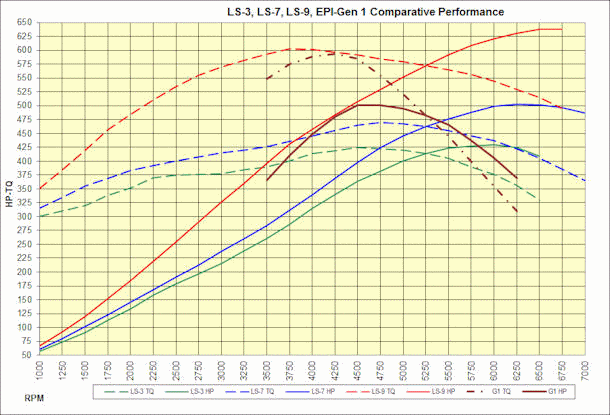
Engine Performance Comparison
The Bigger Issue
A major issue with these engines is the fact that all the LS engines are electronically controlled by a dedicated computer system (aka Engine Control Unit, or ECU). That system (computer, sensors, injector solenoids, spark coils, and wiring) completely controls the engine's fuel delivery and the spark timing, and a host of other variables as well. Many of the newer engines have "fly-by-wire" throttles (no direct connection between the gas pedal and the butterfly). Although the level of control provided by these systems is remarkable, there remains the problem of reliability, fail-safe operation, and the question of "What do I do when the engine fails (or even hiccups) at when I am 300 feet off the ground on takeoff at Vx ?"
CLICK HERE for an expanded discussion of electronic engine controls in an aircraft application.

